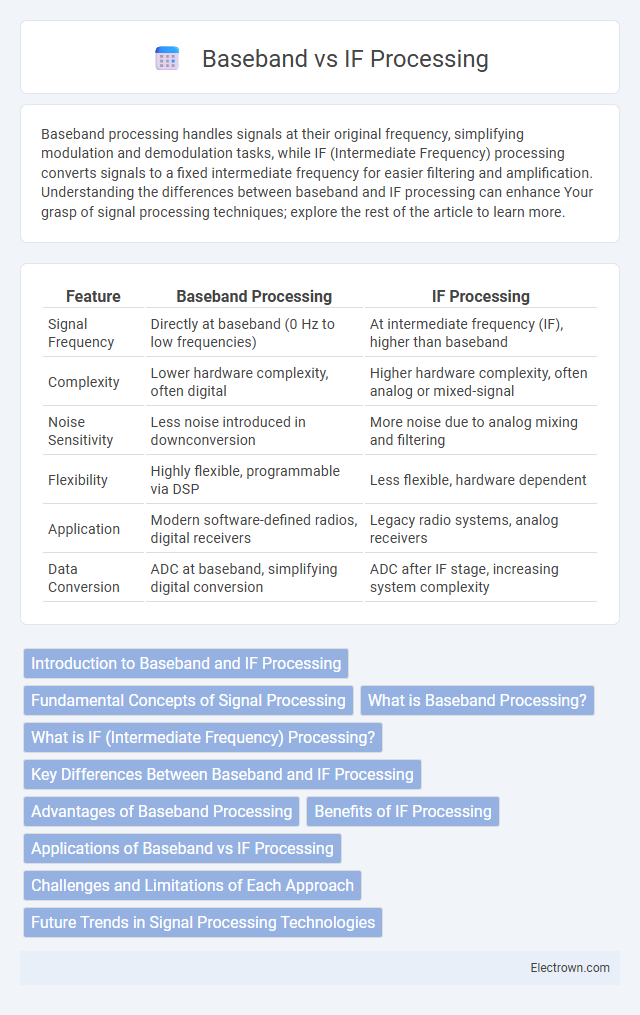Baseband processing handles signals at their original frequency, simplifying modulation and demodulation tasks, while IF (Intermediate Frequency) processing converts signals to a fixed intermediate frequency for easier filtering and amplification. Understanding the differences between baseband and IF processing can enhance Your grasp of signal processing techniques; explore the rest of the article to learn more.
Table of Comparison
| Feature | Baseband Processing | IF Processing |
|---|---|---|
| Signal Frequency | Directly at baseband (0 Hz to low frequencies) | At intermediate frequency (IF), higher than baseband |
| Complexity | Lower hardware complexity, often digital | Higher hardware complexity, often analog or mixed-signal |
| Noise Sensitivity | Less noise introduced in downconversion | More noise due to analog mixing and filtering |
| Flexibility | Highly flexible, programmable via DSP | Less flexible, hardware dependent |
| Application | Modern software-defined radios, digital receivers | Legacy radio systems, analog receivers |
| Data Conversion | ADC at baseband, simplifying digital conversion | ADC after IF stage, increasing system complexity |
Introduction to Baseband and IF Processing
Baseband processing involves handling signals at their original frequency range, typically starting from zero Hz up to a certain bandwidth, enabling direct digital modulation and demodulation in communication systems. Intermediate Frequency (IF) processing shifts signals to a fixed frequency between the baseband and radio frequency (RF), facilitating easier filtering and amplification in receiver architectures. Both techniques are fundamental in modern transceivers, each optimizing system performance based on design constraints and application requirements.
Fundamental Concepts of Signal Processing
Baseband processing involves handling signals at their original low-frequency range, enabling efficient digital filtering and modulation techniques crucial for accurate data recovery. Intermediate Frequency (IF) processing shifts signals to a higher frequency range before final demodulation, simplifying the design of selective filters and amplifiers. Understanding these fundamental signal processing concepts allows you to optimize communication system performance by choosing the appropriate processing stage based on signal characteristics and hardware capabilities.
What is Baseband Processing?
Baseband processing involves handling signals at their original, low-frequency range before modulation or after demodulation, enabling efficient digital signal manipulation and filtering. It is essential in communication systems for tasks like encoding, decoding, and error correction, providing a fundamental layer for transmitting data accurately. Your devices rely on precise baseband processing to convert complex signals into usable information for seamless connectivity.
What is IF (Intermediate Frequency) Processing?
IF (Intermediate Frequency) processing involves converting a received high-frequency signal to a lower, fixed intermediate frequency to facilitate easier and more efficient signal filtering, amplification, and demodulation. This technique improves selectivity and sensitivity in communication systems by allowing the use of standardized, high-performance electronic components at a consistent frequency. IF processing is commonly employed in radio receivers, radar systems, and various wireless communication devices to optimize signal quality before final baseband conversion.
Key Differences Between Baseband and IF Processing
Baseband processing involves handling signals at their original low-frequency spectrum, typically near zero frequency, enabling direct modulation and demodulation in communication systems. IF processing operates at an intermediate frequency, serving as a bridge between high-frequency RF signals and baseband signals, facilitating easier filtering and amplification. Key differences include frequency range, complexity of circuitry, and susceptibility to noise, with baseband offering simpler processing but IF providing better selectivity and image rejection.
Advantages of Baseband Processing
Baseband processing offers significant advantages, including enhanced signal accuracy and reduced hardware complexity by directly handling signals at their original frequencies. Your system benefits from lower power consumption and improved flexibility, enabling efficient software-defined radio (SDR) implementations and easier integration with digital signal processing algorithms. These factors contribute to cost-effective, scalable communication solutions ideal for modern wireless applications.
Benefits of IF Processing
IF processing offers enhanced signal integrity by allowing easier filtering and amplification at intermediate frequencies, which reduces noise and distortion. This method simplifies the design of analog components and improves overall system flexibility, supporting a wider range of frequencies and modulation schemes. Your communication system can achieve higher performance and adaptability by leveraging the advantages of IF processing.
Applications of Baseband vs IF Processing
Baseband processing is essential in applications requiring direct manipulation of signal components, such as digital communication systems, software-defined radios, and audio processing, where signals are handled at their original low-frequency range. IF (Intermediate Frequency) processing is preferred in radar systems, satellite communications, and wireless receivers, enabling easier filtering and amplification before final demodulation. Your choice between baseband and IF processing depends on factors like system complexity, frequency conversion needs, and signal quality requirements.
Challenges and Limitations of Each Approach
Baseband processing faces challenges such as increased complexity in handling wideband signals directly, requiring sophisticated analog-to-digital converters with high dynamic range. Intermediate Frequency (IF) processing limits the signal bandwidth before digitization, reducing ADC demands but introduces phase noise and image rejection issues that can degrade signal integrity. Your choice between baseband and IF approaches depends on balancing hardware complexity against signal fidelity requirements in specific communication system designs.
Future Trends in Signal Processing Technologies
Future trends in signal processing technologies emphasize the integration of AI-driven algorithms within both Baseband and IF processing stages to enhance real-time data interpretation and communication efficiency. Advanced semiconductor materials and architectures are driving improvements in power consumption and processing speed, enabling more sophisticated signal demodulation and filtering capabilities. Your communication systems will benefit from these innovations by achieving higher bandwidth, reduced latency, and improved signal integrity in next-generation wireless networks.
Baseband vs IF Processing Infographic

 electrown.com
electrown.com